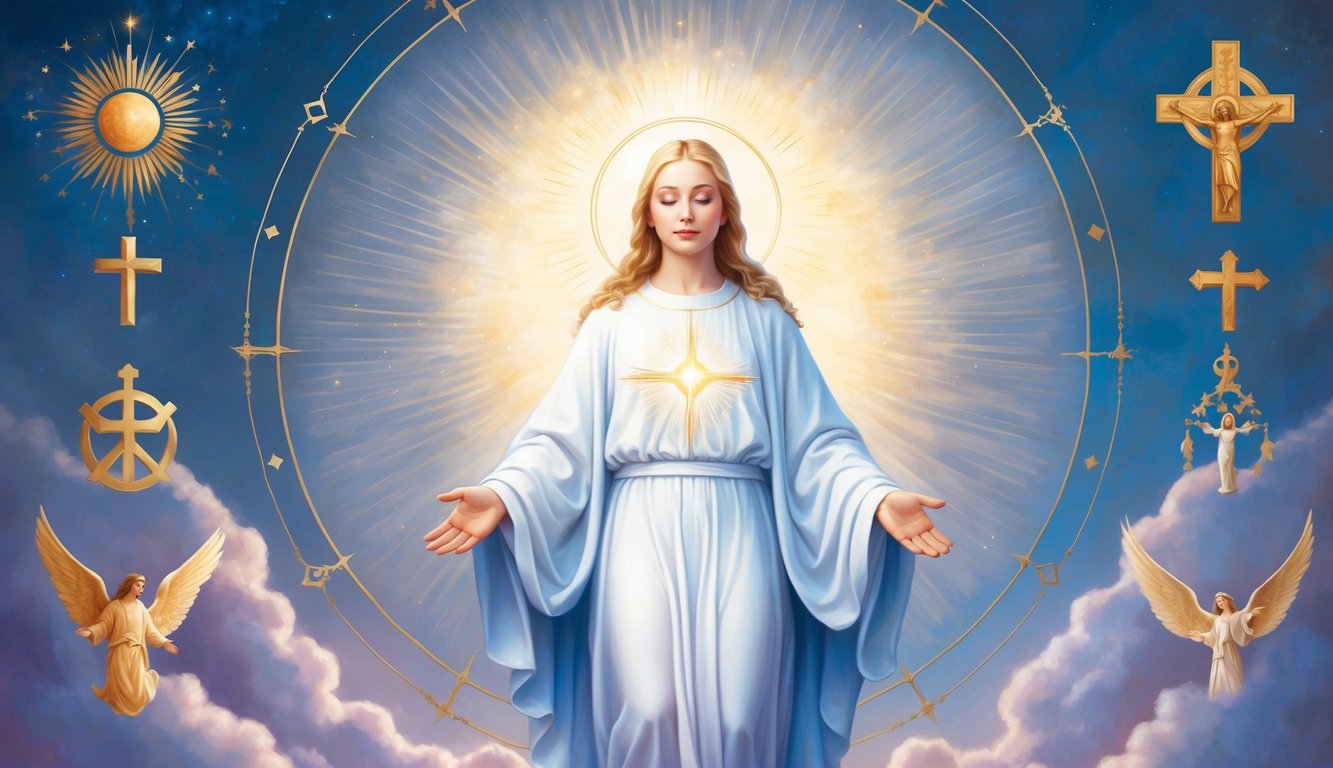Don’t Miss Out On This Unique Astrological Opportunity
Are you tired of spinning your wheels and getting nowhere? Simply put, you’re out of sync: you’re out of alignment with your astral configuration.
But: there’s a kind of map that can help you reclaim your alignment. Think of it as your own personal blueprint to success and happiness: a blueprint that will help you live your most amazing life.
Get started here.
The Magnificat is a powerful hymn found in the Gospel of Luke, where Mary praises God with humility and gratitude.
Mary’s deep connection to God’s promises and the fulfillment of those promises through Christ is reflected in this hymn.
As you explore, you’ll find its roots in Jewish tradition and its impact on Christian theology.
Many find the structure and language of the Magnificat both poetic and profound.
It highlights themes of justice and the reversal of social order, which resonate with many who seek freedom and liberation.
The hymn has also inspired countless works of art and music throughout the centuries, showing its enduring impact on culture.
Understanding the Magnificat can deepen your appreciation for its theological significance and its role in Christian devotion.
Whether you’re interested in its literary form or its broader cultural influence, the Magnificat offers rich insights for both believers and the curious.
Key Takeaways
- The Magnificat is a key hymn in the Gospel of Luke that praises God.
- It combines themes of justice with elements from Jewish tradition.
- The hymn has a lasting influence on art and Christian theology.
Historical and Scriptural Context
The Magnificat is a powerful hymn found in the Gospel of Luke, highlighting Mary’s deep faith and her encounter with her cousin Elizabeth.
Historically, this canticle is rich with Jewish tradition and has been interpreted by early Christians as a profound expression of God’s promise and salvation.
Origin in the Gospel of Luke
The Magnificat appears in Luke 1:46-55, where Mary, filled with the Holy Spirit, praises God for His blessings and mercy.
This passage is set after the Angel Gabriel visits Mary, announcing that she will give birth to Jesus.
Mary’s response is a song of joy and prophecy, reflecting her knowledge of Jewish scriptures and her belief in God’s promises.
This hymn becomes an essential part of the narrative about Jesus’ beginnings, illustrating Mary’s role in God’s plan and expressing themes of justice and faithfulness from the Old Testament.
Mary’s Encounter with Elizabeth
Mary’s visit to her cousin Elizabeth is a significant event leading to the Magnificat.
When Mary greets Elizabeth, who is pregnant with John the Baptist, Elizabeth is filled with the Holy Spirit and proclaims Mary blessed among women.
This encounter sets the stage for the Magnificat, as Elizabeth’s words affirm Mary’s faith.
The meeting symbolizes a connection between the Old and New Testaments, with both women playing key roles in fulfilling God’s salvation plan.
Jewish and Early Christian Interpretations
The Magnificat is deeply rooted in Jewish scripture.
It shares similarities with the Song of Hannah from 1 Samuel, emphasizing God’s power and mercy.
Early Christians saw this hymn as a bridge between Judaism and Christianity, highlighting the historical covenant.
Christians interpreted it as a message of hope and deliverance, celebrating God’s intervention in human history.
This understanding helped shape Christian theology, using the Magnificat as a lens through which God’s justice and the promise of redemption were viewed.
Literary Analysis

When examining the Magnificat, you discover a rich tapestry of literary elements, themes, and uses in worship.
Structure and Literary Devices
The Magnificat is structured as a hymn of praise, often considered poetry within the Gospel of Luke.
It uses repetition and parallelism, enhancing its rhythmic and memorable qualities.
The text emphasizes key elements through contrast, such as Mary’s humble state versus God’s greatness. Semitic poetic techniques are present, highlighting the unique language style of the time.
The poetry here invites reflection on how the divine interacts with humanity.
Key Themes and Theology
In the Magnificat, you encounter central themes including God’s mercy and strength. God’s mercy is a foundational element, showing divine preference for the humble.
The hymn reflects themes of reversal, where the lowly are lifted, and the mighty are brought low.
These themes resonate with the broader theology of freedom and liberation.
This points to a vision where the Lord acts as the Savior of all people, emphasizing a just and compassionate divine plan.
This message of divine justice and mercy aligns with the broader biblical narrative, where God’s word serves as a guiding light for believers.
The psalm 119:105 meaning reinforces this idea, stating, “Your word is a lamp to my feet and a light to my path,” which reflects how God’s guidance brings clarity and hope to the faithful.
In the Magnificat, this assurance is echoed through Mary’s proclamation, emphasizing trust in God’s promises and His enduring care for the oppressed.
Use in Liturgy and Hymns
The Magnificat holds a significant place in Christian liturgy.
It is regularly recited or sung during services, especially in vespers and evening prayers.
As a hymn, it has inspired numerous musical compositions, enriching worship through its melodic and theological depth.
Its frequent use underscores the importance of reflecting on Mary’s voice and the overarching message of hope and divine faithfulness.
In liturgical contexts, it serves as a powerful reminder of the promise and joy found in a relationship with God.
Theology and Mariology

The Magnificat, also known as the Song of Mary, is a powerful piece in the context of theology and Mariology.
This hymn, “Magnificat Anima Mea Dominum,” reflects on themes of mercy and humility, and plays a significant role in Marian devotion.
Mary as Theotokos
Mary, revered as Theotokos or “God-bearer,” holds a central role in Christian theology.
When you think about the term, it emphasizes her as the mother of Jesus, the Savior.
This title reflects Mary’s special status as the mother of God and highlights her importance in salvation history.
Her influence extends into the Magnificat, where she expresses profound faith and trust in God’s promises.
Her words display a deep understanding of God’s mercy and a fearless commitment to His will.
The Magnificat shows her recognition of her blessed state and God’s mighty works.
The theology surrounding Mary as Theotokos often explores her unique relationship with her son, emphasizing her crucial role in the divine plan.
Her acceptance of God’s will serves as an example for believers, encouraging a faithful response to God’s call.
The Magnificat and Marian Devotion
The Magnificat, also known as the Ode of the Theotokos, plays a significant role in Marian devotion.
This hymn reflects Mary’s joy and gratitude, acknowledging God’s mercy and strength.
Mary praises God, celebrating how He uplifts the humble and fills the hungry.
You can see how the Magnificat reinforces her devotion and her role as a model of faith.
It inspires countless people with its message of hope and God’s faithfulness.
Marian devotion often includes reciting the Magnificat, highlighting its significance in personal and communal prayer.
Through this devotion, believers honor Mary’s role in salvation and celebrate her as a vessel of God’s grace.
This practice strengthens one’s faith and deepens the appreciation of Mary’s role as a source of inspiration and guidance.
The Magnificat in Art and Culture
The Magnificat has been a significant influence in both sacred art and music.
It’s found in various art forms, from illuminated manuscripts to choral compositions.
These works often highlight themes of devotion and majesty.
Inspiration for Sacred Art
In sacred art, the Magnificat often appears in the Book of Hours, a Christian devotional book popular in the Middle Ages.
Artists used vibrant colors and intricate designs to reflect its powerful message.
The use of Latin text often added an air of solemnity and reverence.
This depiction provided both visual and spiritual engagement, offering worshippers a deeper connection to its themes of faith and humility.
Throughout history, these artistic representations have served as both decoration and inspiration.
They often included scenes of the Virgin Mary and angels, emphasizing the divine nature of the text.
You might notice how artists employed symbolism to convey deeper meanings, using elements like light to signify divine presence.
Influence on Music and Literature
In music, the Magnificat genre is central in choral compositions.
Composers like Bach and Rutter have created pieces that explore its emotional and spiritual depth.
You might find different stylistic approaches, from grand and powerful to soft and reflective, which show the text’s versatility.
Literature has also seen the Magnificat’s influence, appearing in various narratives and discussions.
It often symbolizes hope and resilience, especially in contexts of struggle and redemption.
In both music and literature, the Magnificat continues to be a source of creative inspiration, resonating with audiences across cultures and ages.
Frequently Asked Questions

The Magnificat is a crucial element of Christian traditions.
This section explores its significance, contexts for use, historical controversies, and thematic ties to social justice.
Why is the Magnificat considered an important prayer in Christian traditions?
The Magnificat, also known as the Song of Mary, is a hymn of praise found in the Gospel of Luke.
It is important because it expresses Mary’s gratitude and reverence towards God, highlighting themes of humility and divine justice.
How does the Magnificat reflect Mary’s response to God’s will?
In the Magnificat, Mary displays deep obedience and acceptance of her role as the mother of Jesus.
Her words reflect a profound faith and willingness to align with God’s plan, celebrating God’s mighty deeds and mercy.
In what contexts is the Magnificat typically used or recited within Christian liturgy?
The Magnificat is often recited during liturgical services, especially in evening prayers like Vespers.
It is also used in celebrations of Marian feasts and other religious events where praise and reflection on Mary’s role in salvation are emphasized.
What historical reasons are there for the Magnificat being banned in certain periods?
At times, the Magnificat has been viewed as revolutionary due to its themes of social justice and challenging of the powerful.
Its recitation was banned in some political regimes wary of its influence on encouraging societal change and empowerment of the marginalized.
How does the Magnificat relate to social justice and humility themes in Christian theology?
The Magnificat emphasizes the uplifting of the humble and the scattering of the proud.
It highlights God’s preference for the lowly and oppressed.
This aligns with theological teachings that focus on justice, mercy, and the reversal of worldly hierarchies.
What are the differences between the Magnificat text in the Bible and its various musical settings?
The biblical text of the Magnificat has inspired numerous musical settings throughout history.
These settings vary in style and complexity.
They range from simple chants to intricate compositions by renowned composers.
Each setting adds unique interpretations while maintaining the core biblical message.



